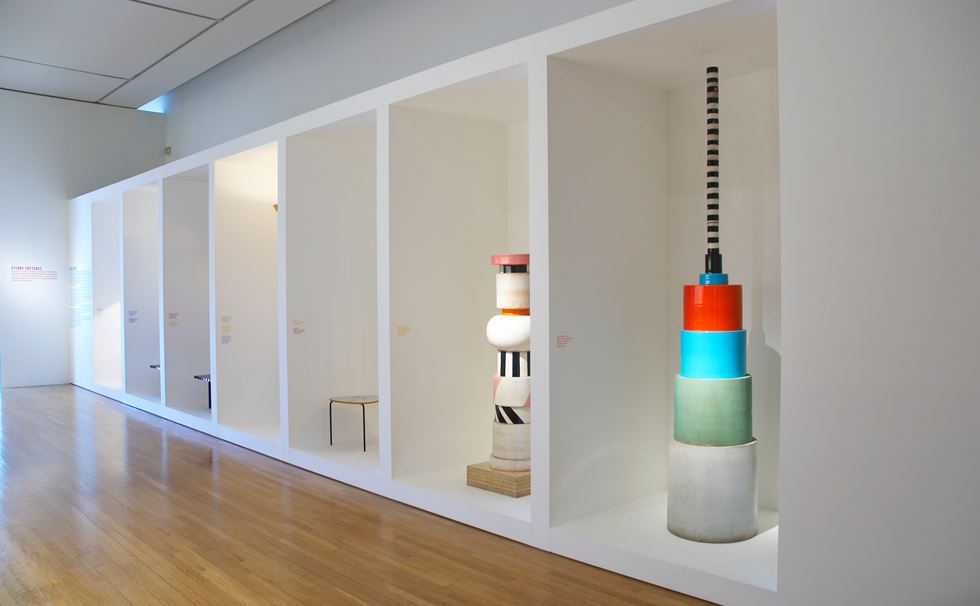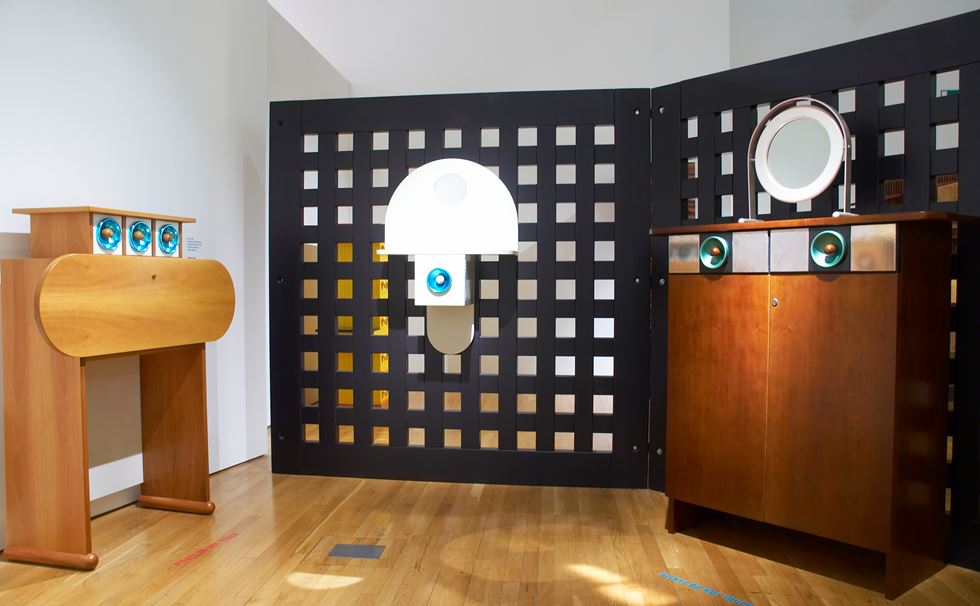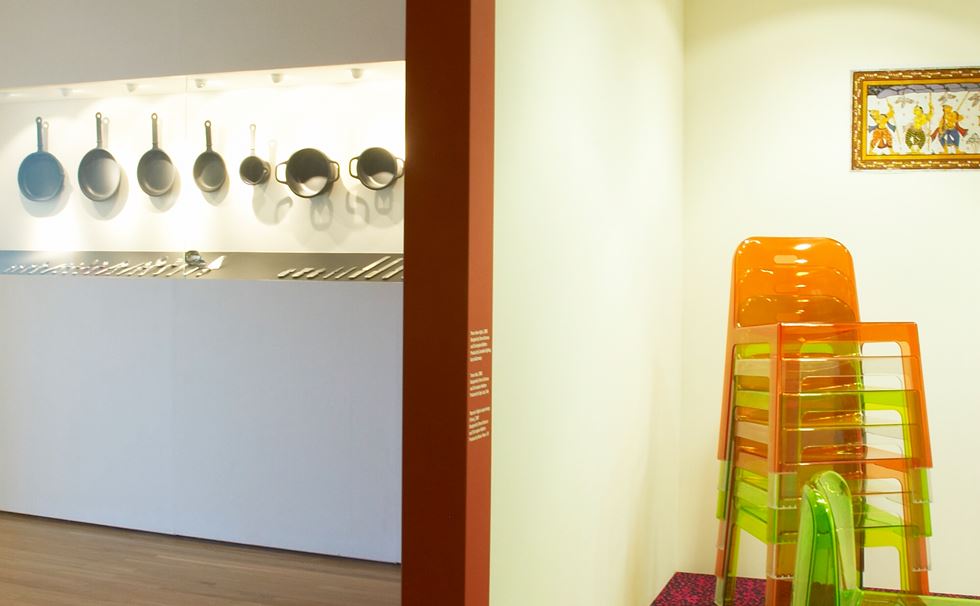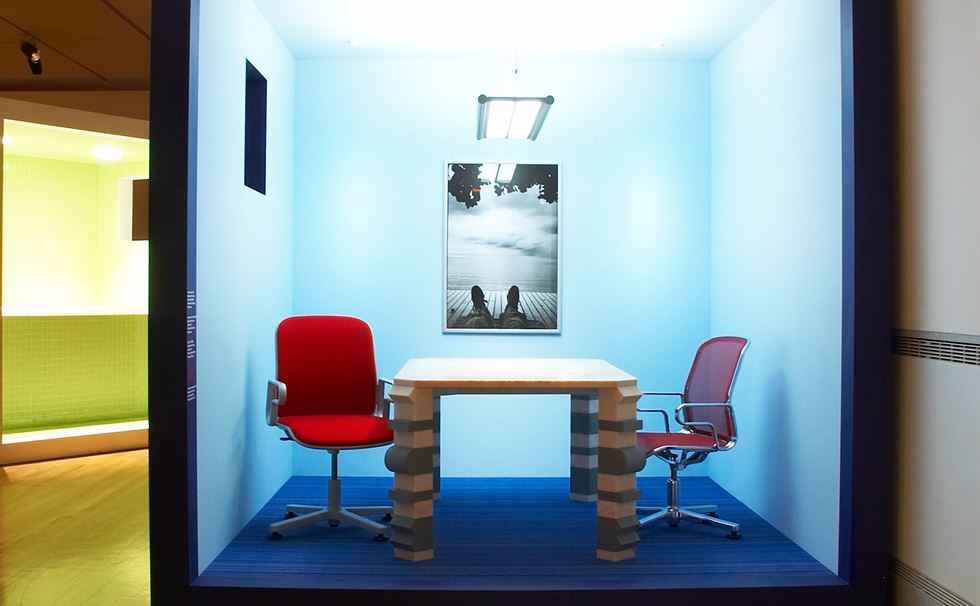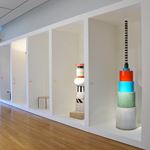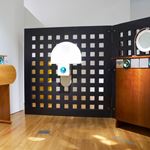Profile
Ettore Sottsass
Ettore Sottsass was a pivotal figure of the late 20th century Italian design scene. Best known as the founder of the early 1980s Memphis collective, he also designed iconic products for Olivetti, as well as beautiful glass and ceramics.
An Introduction
Wherever he went, Ettore Sottsass carried a camera to photograph anything that caught his eye. Doors, temples, kitchens, billboards: nothing escaped him. This was a man who once took 1,780 photographs on a twelve day trip to South America; who toyed with publishing a book consisting of pictures of walls; and a man who, for years, photographed every hotel room in which he had slept with a woman.
Once in Marseille, Sottsass was snapping at a barber’s shop sign when he was forced to surrender his camera. It was a smuggler’s nookie nest. In Egypt, he was photographing a rotting window when the police pounced. The window belonged to a police station. "Most normal people (not just policemen) don’t like to face the reality that all things eventually decay," he wrote later. "I believe that the future only begins when the past has been completely dismantled, its logic reduced to dust and nostalgia is all that remains."
Ettore Sottsass devoted his life and work to dismantling the past in his various roles as artist, architect, industrial designer, glass maker, publisher, theoretician and ceramicist. The past to him was the rationalist doctrine of his father, Ettore Sottsass Sr., a prominent Italian architect. Fond though he was of his parents, Ettore Jr. favoured a different approach. "When I was young, all we ever heard about was functionalism, functionalism, functionalism," he once said. "[Functionalism] It’s not enough. Design should also be sensual and exciting."
Origins and Beginnings
Born in Innsbruck in his mother’s native Austria in 1917, Ettore Jr. was marked out as an architect from an early age. His parents moved to Turin in 1929 because it boasted the best architecture faculty in Italy and Ettore Sr. wanted his son to study there. Although he also loved painting, Ettore Jr. acquiesced to his father’s wishes and gained an architecture degree in 1939 from the Politecnico di Torino.
Almost as soon as he had graduated, Ettore was called up into the Italian army, only to spend most of World War II in a Yugoslavian concentration camp. "There was nothing courageous or enjoyable about the ridiculous war I fought in," Sottsass wrote. "I learned nothing from it. It was a complete waste of time." After the war, he worked on housing projects with his father before moving to Milan in 1946 to curate a craft exhibition at the Triennale. For the next decade, Sottsass continued to curate as well as pursuing his passion for painting; writing for Domus, the art and architectural magazine; designing stage sets; and founding a practice as an architect and industrial designer.
Industrial Design
In 1956, Sottsass and his first wife, Fernanda Pivano, travelled to New York. "It really did look like (Fritz Lang's 1926 film) Metropolis: everybody rushing around, no one caring a hoot," he recalled. "It was incredible, in fact, I changed inside out." He was commissioned to create a line of ceramics during this visit, but was also inspired to concentrate on industrial design, rather than architecture, after spending a month working in the studio of the US designer, George Nelson.
Back in Italy, Sottsass agreed to become a creative consultant to Poltronova, a furniture factory near Florence. In 1958 he accepted a more demanding consultancy role for the newly created electronics division of Olivetti, the Italian industrial group. He kept this role for almost thirty years. Sottsass was hired by Adriano Olivetti, the founder, to work alongside his son, Roberto. Together with the engineer, Mario Tchou, they created a series of landmark products, which were technically innovative, and aesthetically appealing thanks to Sottsass’ love of Pop Art and Beat culture. They won the prestigious 1959 Compasso d’Oro with the Elea 9003, the first Italian electronic calculator (computer). Moreover they revolutionised typewriter design with Olivetti’s first electronic model, the Tekne, in an elegantly angular Sottsass case.
Throughout the 1960s, Sottsass travelled in the US and India while remaining a central figure in the Italian avant-garde scene. During this time he continued to design even more landmark products for Olivetti, culminating in the bright red, poppy plastic 1969 Valentine typewriter which he described as "a biro among typewriters". Although Sottsass later dismissed the Valentine as "too obvious, a bit like a girl wearing a very short skirt and too much make-up, it is still seen as an iconic ‘pop’ product. His furniture was equally influential: notably the mid-1960s "superbox" closets in stripy plastic laminate developed for Polotronova. In 1972, Sottsass’ mobile, multi-functional fibreglass furniture unit was the toast of the ‘Italy: The New Domestic Landscape’ exhibition at MoMA, New York. In the 1970s Alessi, a major housewares and kitchen supplies Italian company, hired Sottsass who created a number of objects for the company including condiments sets and cutlery.
Memphis
By the late 1970s, Sottsass was working with Studio Alchymia, a group of avant-garde furniture designers including Alessandro Mendini and Andrea Branzi, on an exhibition at the 1978 Milan Furniture Fair. Two years later, Sottsass, then in his 60s, split with Mendini to form a new collective, Memphis, with Branzi and other collaborators including Michele De Lucchi, George Sowden, Matteo Thun and Nathalie du Pasquier.
Memphis embodied the themes with which Sottsass had been experimenting since his mid-1960s ‘superboxes’: bright colours, kitsch suburban motifs and cheap materials like plastic laminates. This time, however, these thematics captured the attention of the mass media as well as the design cognoscenti, and Memphis (named after a Bob Dylan song) was billed as the future of design. For the young designers of the era, Memphis was an intellectual express lane, which liberated them from the dry rationalism they had been taught at college and enabled them to adopt a more fluid, conceptual approach to design. Despite the fact that Memphis collective’s work was exhibited all over the world, Sottsass quit in early 1985. He had seen Memphis as a temporary pursuit, which he had developed whilst founding Sottsass Associati.
Sottsass Associati
Sottsass Associati was the architecture and design group where Sottsass worked with former Memphis members and younger collaborators, including industrial designer James Irvine and architect Johanna Grawunder. Ettore returned to architecture in 1985, when he was commissioned to design a chain of shops for Esprit. He completed a series of private houses – including one in Palo Alto for industrial designer, David Kelley, and public buildings, notably the Malpensa airport near Milan, in 2000. Sottsass Associati has also worked for Apple, NTT, Philips and Siemens, while Sottsass himself continued with his artisanal projects in glass and ceramics.
A celebrated and lasting influence
Revered internationally as a key figure of late 20th century design, Ettore Sottsass is cited as a role model by young foreign designers, such as Ronan and Erwan Bouroullec, for the breadth as well as the quality of his work. As further testimony of his impact, in 1999 Sottsass received the Sir Misha Black medal for his outstanding contribution to the field of design. In the 2000s his work was the focus of a number of exhibitions and retrospectives. For example: the 2006 exhibition ‘Ettore Sottsass’ organised by the Los Angeles County Museum of Art, which was the first major retrospective on Sottsass’ work in the USA, and the ‘Ettore Sottsass – Work in Progress' exhibition displayed at the Design Museum in 2007.
Ettore Sottsass Jr. died at age 90, on the last day of 2007. However his creations continue to inspire new designers and are the subject of newly published books and anthologies.
Image Credits
(Portrait) Ettore Sottsass, circa 1970 © Ettore Sottsass and Barbara Radice, courtesy Archivio Ettore Sottsass
Detail of 'Carlton', a room divider designed by Ettore Sottsass in 1981. Displayed at the Design Museum's exhibition 'Ettore Sottsass – Work in Progress' in 2007. Image credits: Andy Stevens.
Detail of Ettore Sottsass' ceramic Totems, displayed at the Design Museum's exhibition 'Ettore Sottsass – Work in Progress' in 2007. Image credits: Andy Stevens.
Detail of the graphics featured at the 'Ettore Sottsass – Work in Progress' exhibition at the Design Museum in 2007. Image credits: Andy Stevens.
Detail of the Valentine display at the Design Museum's exhibition 'Ettore Sottsass – Work in Progress' in 2007. Image credits: Andy Stevens. Valentine was an iconic typewriter Sottsass designed for Olivetti in 1969.
Detail of a cupboard designed by Ettore Sottsass Jr.. Design Museum.
Detail of photo-collage featured at the 'Ettore Sottsass – Work in Progress' exhibition at the Design Museum in 2007. Image credits: Andy Stevens.
Detail of the introductory wall panel featured at the 'Ettore Sottsass – Work in Progress' exhibition at the Design Museum in 2007. Image credits: Andy Stevens.
Detail of a calculator designed by Ettore Sottsass. Design Museum.



